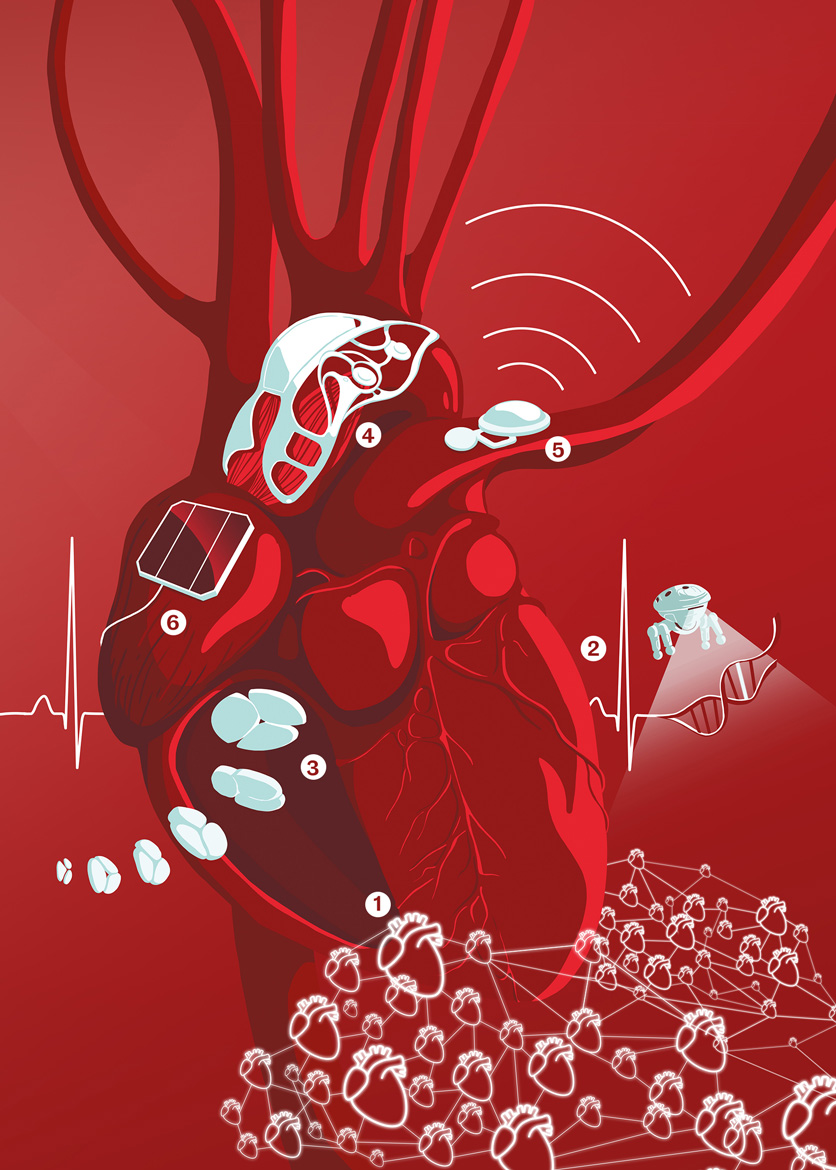CARDIOLOGY
The heart of the matter
Cardiovascular disease is the most common cause of death in Switzerland. That’s why intensive research is being conducted into the organ that pumps our blood. We take a look at six innovative projects.

Illustration: Christina Baeriswyl
Solar and fuel cells. University of Bern and ETH Zurich
Modern pacemakers enable many patients to enjoy a high quality of life. But they have one drawback: when the batteries run out, the pacemaker has to be replaced in another operation. This is why researchers at the University of Bern have been investigating how to power a pacemaker by means of a small solar cell inserted under the skin. Just 10 minutes of midday sunlight every day can provide sufficient power. But since there are days when there’s insufficient light outside, the device also needs a battery that has a storage capacity big enough to act as a backup. Researchers at ETH Zurich are adopting a new approach that could make such a battery superfluous. They have developed a fuel cell that can be implanted in the body to generate electrical energy from surplus sugar in the blood.
Sensor-sender. EPFL/University Hospitals of Geneva/Lucerne University
When patients suffer heart failure, their treatment has to be adapted to the current condition of their heart, which means monitoring it constantly. Today, this necessitates regular visits to the intensive care unit, where the staff use a catheter to insert measuring devices into the body. Researchers from EPFL, Lucerne University and the University Hospitals of Geneva are now developing a miniaturised system that can be implanted in the body to measure cardiac output in the course of one’s everyday life, sending the data in real time to medical providers. Several sensors are placed in a miniaturised casing that is then implanted permanently in the pulmonary artery using a simple procedure. An ultrasound connection provides the power needed by the device, and also transmits the measurements from inside the body. Laboratory experiments with the device have been successful, and the team is now aiming to gain approval for its clinical use.
Electrically controlled elastic materials. EPFL
Many people with heart failure need a heart pump. But the existing mechanical implants are mostly made of rigid materials and often cause complications like blood clots. Researchers at EPFL want to avoid this by using an artificial auxiliary muscle made of soft materials. To achieve this, they’ve developed a ring made of a very elastic kind of plastic that has electrodes integrated into it. If a voltage is applied to the ring, it creates an electric field with opposing charges that attract each other. By varying the voltage, the ring can be made to contract and expand, just like a muscle. After initial experiments on the heart of a pig, the researchers are now optimising the pumping power. “Our goal is to achieve a support capacity equivalent to some 20 percent of the capacity of the human heart”, says Yves Perriard, the head of the project. “At the same time, we’re developing a surgical procedure to enable us to place the artificial muscle around the main artery of the heart in a manner that is as minimally invasive as possible”.
3 — REPAIR: When the heart valve is too big
Tissue engineering. University of Zurich
Researchers at the University of Zurich are busy developing an artificial heart valve by growing a kind of tissue that can regenerate itself. A prosthesis such as this could be integrated fully by the body and potentially last a lifetime, growing together with the body’s own tissue. This could significantly improve the quality of life of children with congenital heart defects. Today, the artificial heart valves that are utilised in such cases always have to be replaced over time by means of surgery. These regenerating heart valves have already been tested in sheep. Now the researchers are looking to use them in humans. “We are combining several different methods to develop an innovative approach”, says Sarah Motta, a member of the research team. “Thanks to laboratory experiments, computer models and animal testing, we can now improve how to predict and control the long-term adaptation of these heart valves”.
2 — PREVENTION: No more sudden cardiac deaths!
Personalised heart medicine. Cantonal Hospital of Lugano
Brugada syndrome is a rare form of heart disease that can lead to an increased risk of arrhythmia and sudden cardiac death. Up to now it has been almost impossible to organise any targeted treatment for it. But a team led by Giulio Conte of the Cantonal Hospital of Lugano is hoping to change this. They are using a computer model to combine data from many of those affected, including genetic information, electrocardiographs (ECGs), 3D images of electrical signals and magnetic resonance imaging (MRI). “These studies have improved our understanding of the pathophysiological mechanisms of cardiac arrhythmia in people with Brugada syndrome”, says Conte. “It’s paving the way for customised therapies”.
1 — PREVENTION: AI hunts for symptoms in women
A pan-European statistical analysis. University of Zurich
Women who suffer a heart attack are more likely to die than men. This is because doctors often misinterpret symptoms that are women-specific and so do not initiate the appropriate treatment. Researchers at the University of Zurich have now been analysing the data of more than 400,000 patients from all over Europe, their aim being to develop algorithms capable of conducting a more targeted assessment of an individual’s risk of heart attack. “This new tool has been in use for a short time now”, says Thomas Lüscher, the study leader. It is enabling their AI to refine its assessments more and more, he says, by autonomously comparing them with the constantly expanding statistics on heart disease. “Whether this will actually improve treatment for women will soon become evident thanks to those self-same databases”, he says.




